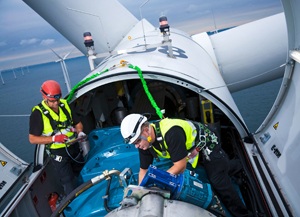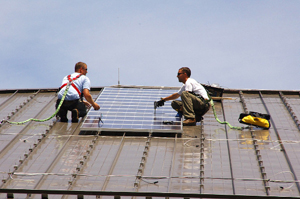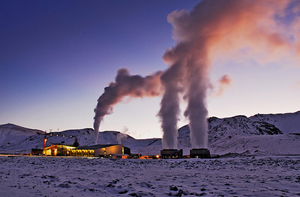Europe's green energy chaos
on
Europe's green energy chaos
The EU's climate and energy policies are too expensive, too ambitious, too complex - and ineffective to boot, argues Andrew MacKillop. Brussels' blind faith in drastically reducing CO2 emissions and liberalising energy markets will profit only a select group of companies and officials at the expense of everyone else. EU officials would do well to rethink their plans - before the public rises up in anger.
 |
| Engineers working at Sweden's Lillgrund offshore wind farm (photo: Siemens) |
How happy should we be with this? It is important to note that this energy transition is the most massive energy programme ever proposed anywhere in the world outside war-time conditions. The challenges, costs and risks of this vastly ambitious plan are commensurately large.
The main goals of the European climate-energy package are:
1) radically reducing dependence on fossil fuels – and radically increasing dependence on renewable, unconventional and alternative “low carbon green” energy sources
2) heavily improving energy efficiency, massively conserving energy and rationalising the energy economy from top to bottom.
And all this in the space of about 15 years!
The transition is deemed urgent and necessary for three major reasons:
- global warming, whatever the scientific reality of this supposed crisis
- the fact that Europe relies to a large extent on high priced and unsure supplies of imported oil and gas, despite its huge reserves of shale, coalseam gas and coal
- hopes that “green” energy will bolster the economy and produce “green” jobs, despite the results to date being unremittingly negative
Let’s look at each of these issues in more detail.
The ineffectiveness of carbon trading
There are other more diffuse policy goals for Europe’s climate and energy policies, but it is the goals of improving energy supply security and mitigating global warming that result in the extreme targets that the EU has set. The reduction of CO2 emissions, with targets as high as 80% from various baseline
| This energy transition is the most massive energy programme ever proposed anywhere in the world outside war-time conditions |
How realistic and effective is this climate policy? First of all, it should be noted that the EU27 countries have only significantly cut CO2 emissions on a year-by-year basis during sharp economic downturns, most recently in 2008-2010. During periods of growth, most recently 2004-2007, EU27 emissions increased with economic growth and employment, because the economy used more energy, and because 81% of European energy in 2010 was still fossil based. There is a real challenge here.
The European Union’s imposition of mandatory CO2 emissions trading started with the adoption of national CO2 allocation plans (NAPs) in March 2004, and the introduction of market trading in 2005 via the ETS or Emissions Trading Scheme. This was followed by increasingly complex and wide ranging sectoral carbon reduction commitments (CRCs). Additional and increasingly complex tradable instruments were added to the system, with Clean Development Mechanism credits, for cutting CO2 emissions in non-European developing countries, and carbon offsets. Other ingenious “carbon finance” assets and negotiable securities were added by way of financial engineering, through producing derived and related financial products.
But this whole CO2-trading scheme seems to have had very little effect so far. The basic objective of cutting CO2 emissions in Europe was in reality more easily obtained by outplacement, delocalisation and deindustrialisation, economic recession and rising unemployment. The US experience has been similar. The collapse of voluntary CO2 emissions trading in the US and the shutdown of its only carbon trading exchange, Chicago’s CCX, formally in January 2011 but effectively since November 2010, with day traded CO2 prices falling to 5 US cents per ton, underlined the complete loss of US investor confidence in emissions trading. At the launch of the CCX in 2003, bright spirits forecast this market could or might at some stage attain a turnover value of $50 billion to $10 trillion per year.
More importantly, the global trade context is clear: no rival or partner of the European Union applies “carbon correct” policies and in particular does not enforce the trading of CO2 emissions permits allocated by governments. All other major world powers, such as China, India or Russia have refused to promote or mandate CO2 emissions trading, which only serves to underline the fragility of carbon trading as a global, viable administrative initiative and sustainable financial activity.
In reality, so-called “carbon trading” is an effective energy tax which the EU will most certainly not be able to impose on goods or services exported to Europe from outside the Union through trade sanctions and tariff barriers. If it does, this will firstly result in WTO proceedings which Europe will almost certainly lose, but may also cause retaliatory action with an adverse impact on world trade at a very difficult time for the European economy. The EU has very large, structural trade deficits with China, and growing deficits with India and Brazil, which are all hostile to the basic notions and rationale of “carbon trading”.
The nonsense of unbundling
The complex and apparently ineffective CO2 measures are implemented through a large number of European Commission directives, issued on a regular basis, and which are also intended to establish pan-European electricity and gas trading arrangements and markets, similar to the CO2 trading
| The basic objective of cutting CO2 emissions in Europe was in reality more easily obtained by outplacement, delocalisation and deindustrialisation, economic recession and rising unemployment |
The climate and energy package makes heavy use of the notion that by preventing pipelines, power transmission lines and electric power stations being controlled by one company or entity, even if this entity is publicly owned and accountable to all democratic procedures for its control, will enable a “free market” that will create an upsurge in activity by small businesses who will gain entrance to the market. The usual way this notion is sold to voters and to the public is the claim this will automatically produce cheaper energy and more jobs, with additional climate and environment protection frills thrown in as needed. In reality, the climate and energy package favours large industrial conglomerates in the energy sector and, as we know, Europe’s energy market liberalisation since 1996 has coincided with some of the largest energy price rises for final consumers in recent history.
The ideological basis of the energy and climate package remains highly schizophrenic: on the one hand the initiatives are rigorously federalist, integrative and convergent, on the other they are rigidly free-market oriented. The results “on the ground” are however not perceived as positive by the majority of European citizens and increasingly by European national governments, who are more and more opposed to what they see as an unholy alliance between Brussels bureacrats and profit-gouging, subsidy-gouging private corporations.
“Unbundling” has for several years been the leitmotif of the attempts of the European Commission at creating a so-called continental energy space for electricity and gas trading, along with CO2 emissions trading. The rationale is that increased competition between electricity producers will lead to the creation of a pan-European electricity market, which will boost innovation and reduce prices, but this notion is confronted by severe real world limits. At present and very basically, the so-called pan-European electricity market is impossible because it is physically impossible, whatever the Commission might like to pretend on paper. Simple facts rapidly prove this.
The EU’s total electric power capacity of today is about 805 GW. Its current electric power transport capacities are well below 20 GW, and few countries have capacities higher than about 3 GW for country-to-country exchanges. Germany, which has one the most highly developed set of power transport systems in the EU, only has 1 GW of power exchange capacity with the four Northern European countries of Nord Pool, the biggest power exchange system in Europe. This is one quarter of one percent of EU27 electric power capacities. Incidentally, Nord Pool is at present heavily used by Denmark as a sort of “back up battery” for its wind power system, which often necessitates the country to export as much as 60% of its excess production when national demand is low but the wind is blowing hard.
 |
| Installing solar panels (photo: 1BOG.org) |
The notion that electric power producers in Romania can somehow compete with suppliers in Portugal or Ireland or Belgium is therefore transparent nonsense because it is – for now at least – physically impossible, but this is very rarely admitted. What we can be sure of, however, is that electricity trading at local and national scale can and will raise the price of electricity and drive more people into fuel poverty, through the well-known enthusiasm of traders to profit from any shortage that may exist, or can be engineered, using this as a splendid pretext for gouging power prices to extreme highs, with an equally predictable crash of day traded prices afterwards.
The myth of green jobs
Supporters of the “transition” to a green economy, including the European Commission itself, often claim that it will lead to the creation of jobs and reduced expenditure on imported fossil fuels. This is said to justify the massive state handouts to renewable energies.
The idea that the “greentech” sector can create and sustain large numbers of new jobs is totally disproved by reality. Low carbon electricity primarily means wind power, some solar electric power, and
| At present and very basically, the so-called pan-European electricity market is impossible because it is physically impossible, whatever the Commission might like to pretend on paper |
Taking the case of wind power, its total installed capacity in Europe attained about 90 GW in early 2011, some 45% of world total wind power capacity - but this only generates a total of about 105,000 direct jobs in Europe. This is about 0.025% of the continent’s economically active population of 230 million persons and about 0.47% of Europe’s unemployed population as of August 2011. Employment in all other “clean energy” sectors in Europe is of course even lower than in wind power.
More importantly, as Gordon Hughes, Professor of Economics at the University of Edinburgh, wites in a recent report, The Myth of Green Jobs, “job creation” in itself has “no merit as a basis for judging policy”. As Hughes points out, it is easy enough to create jobs by spending money; what really matters is total income or the added value of jobs AND investment in renewable energy production diverts investment from other sectors. If this is taken into account, says Hughes, “a very different picture” emerges “from that depicted by enthusiasts and lobbyists.” As green energy is highly capital-intensive, the target for generating electricity from renewable energy will involve a capital cost that is 9-10 times the amount required to meet the same demand by relying on conventional power plants, according to Hughes. In other words, job “creation” will be LOW OR negative.
It is sometimes said that producing renewable energy will lead to great savings as a result of lower import needs. In 2010, the EU imported almost $300 billion worth of oil and significant amounts of gas. However, it is fallacious to assume that these are somehow net costs to the European economy. Any calculation must include revenues which accrue to European oil companies outside of the EU and inside the EU from trading and refining activities.
In the meantime governments spend massive amounts of money on renewable energy. The main pillars of the EU’s electric power programme are wind power and solar electric power, with as much as 67% of all electric power spending in Europe to 2030 (some €540 billion on a total amount presently estimated at around €900 billion) supposedly going only to these two sources and systems. This would presumably be through the free play of market forces, but in reality will need extremely high and
| The idea that the "greentech" sector can create and sustain large numbers of new jobs is totally disproved by reality |
The climate-energy package’s targets include the goal of sourcing up to 30% of Europe’s total electricity supply, by about 2025-2030, from wind farms and solar power plants - of course if sufficient spending is given for this vast step up in capacity (from about 9% today). It is certain that as a result electricity prices will rise considerably, possibly as much as 33% by 2015 in several major countries of the Union. Total spending requirements to 2030, for wind power and solar electricity could easily exceed €2000 billion, including the obligatory and massive upgrading of Europe’s electric power grids, according to my analysis of the likely costs, if the policy package continues and is not heavily reformed, or simply abandoned.
Plan B
 |
| Geothermal energy power plant (photo: Callfinder) |
At this moment, major political parties in Europe, including some governing parties, are already beginning to distance themselves from the ‘carbon neutral and climate correct’ policy package, due to this rising opposition from the public, trade unions, industrial energy users and analysts. For example, at the annual conference of the UK Conservatives in Manchester in October 2011, the commitment to “carbon neutral and climate correct” policies was notably diluted by major speakers, including the prime minister.
In many countries and in the EU itself climate and energy policies and programmes are already being adjusted or abandoned. This includes the downsizing or cancellation of plans for biofuels production (especially food crop based bioethanol), reduced plans and incentives for massive offshore wind farm development, delays in investments in large-scale electricity grids and interconnections, including so-called smart grid projects, and reduced subsidies and lower feed-in tariffs for solar and wind power.
It is very likely this trend will accelerate as a result of growing political and public opposition, especially in view of the economic crisis. Increasingly, policymakers and the public will come to the conclusion that the EU’s climate and energy package is too ambitious, too expensive, too complex and in the end also ineffective. This could lead to a heavy clash with supporters of the current climate and energy policies, which in turn could result in even worse chaos in the energy market. To avoid such a potentially disastrous situation, it is high time for policymakers to develop a plan B.
|
About the author Andrew MacKillop is a an independent energy analyst and project advisor who has written on energy topics for over 35 years. He worked for the European Commission's Directorate-General of Energy as a policy expert in the 1980s. He can be reached at xtran9@gmail.com. |


Discussion (0 comments)